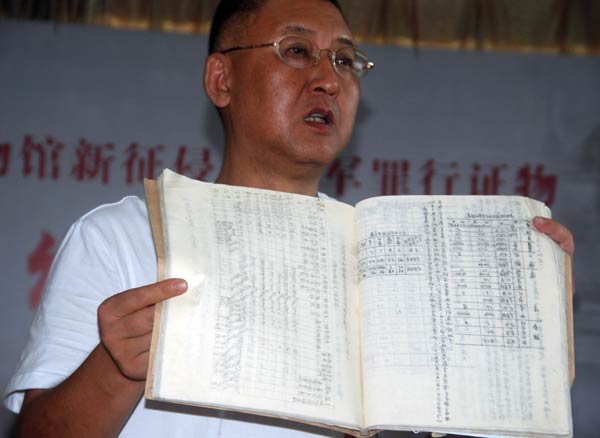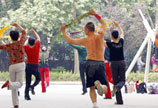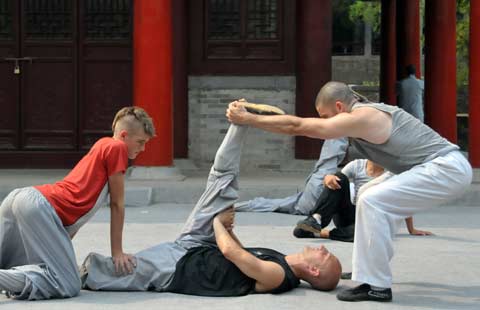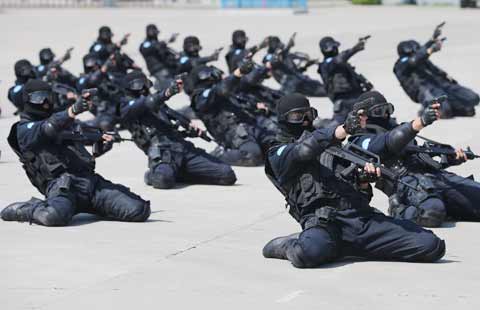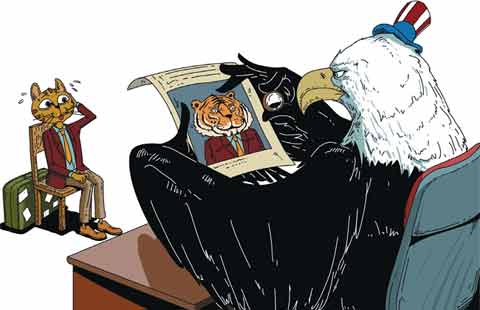Humble dresser is a reminder of atrocities
By Huang Zhiling in Dayi, Sichuan province Updated: 2014-07-28 20:37|
Fan Jianchuan, curator of the Jianchuan Museum Cluster, in Dayi, Sichuan province, displays a list on Sunday showing losses in Hunan and Guangxi during the War of Resistance against Japanese Aggression. Zhong Jiaming / for China Daily |
Experts on the War of Resistance against Japanese Aggression showed a keen interest in an antique dresser on Sunday.
The dresser was one of 437 artifacts relating to wartime Japanese atrocities displayed to 20 historians from across the country at a seminar.
"The dresser was donated by Li Youxia, a resident of the Sichuan provincial capital of Chengdu," said Fan Jianchuan, curator of the province's Jianchuan Museum Cluster at Anren town in Dayi county.
"When Japanese planes bombed Chengdu on June 11, 1939, she was 19 and escaped unscathed in a vegetable field. But her uncle and her janitor perished.
"Her house was reduced to the rubble. Only the dresser remained."
The one-day seminar on Japanese crimes during the war (1937-45) was organized by the cluster, which consists of a number of museums dedicated to the war.
A document sent by the Chengdu branch of the Bank of Sichuan to its Wanxian county office in the east of the province on June 17 tells how Japanese bombers were intercepted by 18 Chinese military planes during the raid that day. It lists the names of the streets and number of houses damaged.
Chengdu underwent 31 indiscriminate bombing attacks by Japan from Nov 8, 1938, to Dec 18, 1944. The dead and injured numbered 5,337, according to the Chengdu Civil Air Defense Office.
A report written by the Quxian county cultural relic management center in eastern Sichuan shows how Japan bombed the county seat in 1940 and 1941 and includes photos of survivors.
On August 21, 1940, Japanese planes dropped more than 40 bombs on Quxian, killing more than 400 people and injuring more than 200.
"The casualties accounted for 7.5 percent of the county seat's population," said Li Zongjie, deputy chief of the Chongqing Local Chronicles Society, who has carried out extensive research into Japanese bombing in the county.
The artifacts include a report written by a Japanese major general in 1963 telling how the Japanese prepared in Taiwan during the war for the invasion of Guangdong province.
Also on show were documents containing regulations drawn up by the Japanese military from 1942 to 1944 to guide its army as it looted assets belonging to Chinese enterprises and Britain, the United States, the Netherlands, Belgium, Canada and Australia.
A report written by the US army after the war tells how three American pilots were captured, tortured to death and incinerated by the Japanese army after their B-20 bomber made a forced landing. The plane landed near Hankou, Hubei province, on November 21, 1944, as it returned from a bombing mission over Tokyo.
Other items include Japanese army knives and bugles donated by Yasuyoshi Shioya, a 93-year-old Japanese veteran.
Shioya was a freshman at a Japanese university when he was forced to join the army at 21. He shot 10 Chinese soldiers dead during battles and remembers vividly the atrocities his division committed.
He visited China 23 times between 1985 and 2007 to express his regret.
- Anti-graft watchdog gets tough in cleanup
- Drills to have 'little impact' on civilian air services
- Humble dresser is a reminder
of atrocities - Report on army cheats sparks concern
- Revision of decree protects military airports
- Scandal-hit China food firm withdrawing all products
- Typhoon Matmo kills 13 in China
- China to upgrade transport infrastructures in Tibet
- VP stresses ecological preservation in pasturing regions
- Direct flight to link China's Wuhan with Moscow
